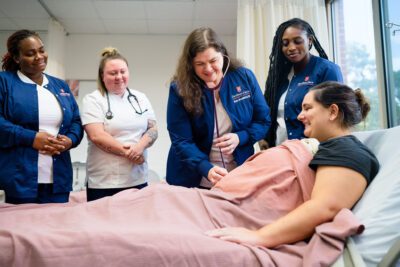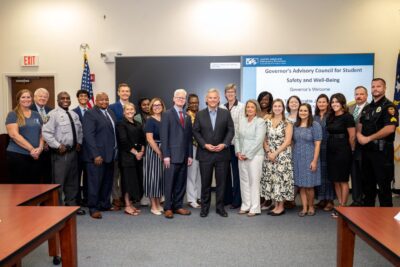
Efforts to align the state’s educational systems with its economic needs were highlighted by officials across the educational continuum at Gov. Josh Stein’s first education cabinet meeting on Tuesday, Oct. 14.
“Fundamentally, student success leads to economic benefit,” Stein said when summarizing the meeting, during which education leaders from early childhood to higher education shared their priorities.
“We’re all focused on, what do we need to do to ensure the people of North Carolina have what it takes to succeed in what is a very fast-changing, ever-changing economy?” Stein said.
The cabinet, established by the state legislature in 1992, is tasked with working across agencies and programs, and “maintaining a strategic design for a continuum of education programs, from early childhood into the workforce,” according to the governor’s website.
![]() Sign up for the EdDaily to start each weekday with the top education news.
Sign up for the EdDaily to start each weekday with the top education news.
Adapting to workforce needs, AI-driven future
System alignment to workforce demands was a common theme across members’ priorities. Stein uplifted the state’s attainment goal, backed by myFutureNC, to reach 2 million North Carolinians by 2030 with postsecondary credentials or degrees valued by industry.
N.C. Community College System President Jeff Cox highlighted Propel NC, a proposed funding model that incentivizes colleges to prioritize program offerings tied to high-demand, high-wage fields. Both Cox and Kenny Flowers, chief deputy secretary of the Department of Commerce, said short-term training opportunities leading to workforce credentials should be expanded as federal Pell Grants are set to open to those programs in the coming year.
One of Stein’s top three priorities centered on workforce development and career readiness. Specifically, he is focused on expanding work-based learning opportunities like apprenticeships (also a Commerce goal), strengthening the health care workforce (also a priority of the Department of Health and Human Services), and supporting the community college system’s Propel NC funding model. Members said these efforts are important to maintain the state’s No. 1 CNBC ranking for business.
“We’ve got a lot of things going for us, but we can’t rest on our laurels,” Stein said. “… We have to continue to invest in young people to make sure that they have what it takes to continue to help us sell the state.”
Related reads



In the K-12 system, Superintendent of Public Instruction Mo Green said he wants students to be required to complete a career and technical education (CTE) course before graduation, alongside a college-level course through the Advanced Placement (AP) program, or the state’s dual enrollment program, Career and College Promise (CCP).
And in higher education, the University of North Carolina (UNC) System is focused on preparing graduates for careers and lives increasingly shaped by artificial intelligence, said Shun Robertson, the system’s interim senior vice president for strategy and policy. The system is launching an online module available across its campuses for students to understand AI’s capabilities and limitations.
“We want North Carolina to be known for graduates who are not just technologically capable, but ethically grounded, people who bring wisdom and community to an increasingly digital world,” Robertson said.
Opening the ‘front door to higher education’
Education leaders are also focused on expanding access and affordability to postsecondary education at two- and four-year colleges and universities.
Multiple leaders highlighted NC College Connect, a program that gives qualifying students direct admission to participating colleges and universities, instead of requiring students to complete applications. High school juniors with GPAs of 2.8 or higher are contacted with an admission notice to a variety of options in the UNC system and private institutions.
Through the program, students will automatically be directed to the traditional application process for their local community college, where they have received direct admission.
Green and Cox said they are eager to continue to strengthen that program, which provided direct admission to about 63,000 public high school seniors this fall. Cox said next year students will also receive phone calls, in addition to physical letters, to let them know of their options.
“I want to get to that 40% of the high school students who aren’t going anywhere to college,” Cox said.
In addition to easing the process of college admission, representatives of the UNC System and the North Carolina Independent Colleges and Universities (NCICU) said they are also focused on lowering the cost of attending college.
The Next NC scholarship, for example, provides students from families making $80,000 or less with at least $5,000 to attend a UNC System school and at least $3,000 to attend any community college.
“So with NC College Connect saying that they have a spot, and Next NC saying that we have money for you, we’re creating a more accessible and transparent front door to higher education in North Carolina,” Robertson said.
Hope Williams, president of NCICU, said one of network’s priorities is advocating for more state funding for tuition assistance through the North Carolina Need Based Scholarship (NCNBS), a scholarship for North Carolina residents attending private colleges and universities.
“That’s how we are preparing our great teachers, our growth in engineering and health care,” Williams said.
She said the system receives about $91 million in NCNBS funding, compared to the about $108 million they received 15 years ago.
“Obviously costs have risen … so it makes it more of a challenge,” Williams said.
Understanding the moment in public education
Green shared three priorities from the Department of Public Instruction’s (DPI) strategic plan that was approved by the State Board of Education (SBE) in August. SBE Vice Chair Alan Duncan also sits on the cabinet. Green highlighted:
- Preparing each student for their next phase of life: Expanding rigorous pathways, dual enrollment, and character development.
- Revering public school educators: Competitive compensation and career advancement opportunities.
- Celebrating the excellence in public education and galvanizing champions to fully invest in and support public education: Comprehensive messaging to highlight successes and building coalitions for increased investment and pride in our schools.
Green said DPI and the Board are also continuing their efforts in aligning reading instruction with the science of reading — as well as strengthening math instruction through a five-year $25 million project funded by the Golden LEAF Foundation supporting 15 middle schools in rural communities.
He said DPI and the State Board are also focused on spotlighting and supporting strengths of public schools and strengthening support and investment in them.
“We really felt like it was important to be sure that we understand the moment that we find ourselves in with regards to public education,” Green said. “We’re seeing decreased enrollment overall in our public schools, and so we know we’ve got to be sure that folks understand the wonderful things that are happening in our public schools, even as we address challenges, and not only telling our story — but then getting folks involved.”
Related reads



Both Green and Stein said increasing educator compensation is a priority. Stein said that the state has a lower average starting teacher salary than all of its bordering neighbors is “disgraceful, and an issue that we must address.”
Green added that, along with higher compensation for educators (including teachers, administrators, and other staff members), other strategies are needed to strengthen the profession, such as career advancement opportunities, stronger recruitment as early as middle and high school, and the removal of burdens on teachers outside of instruction.
‘Both knowledge and well-being’
Multiple members called for increased mental health services and addressing students’ overall well-being.
Lawrence Greenblatt, the state health director and chief medical officer at the Department of Health and Human Services, highlighted Youth Mental Health First Aid, a training that the department has provided to teachers and students so they can better recognize symptoms of mental health struggles and connect others with resources.
DHHS also partners with districts to provide physical and behavioral health services through 13 school-based health centers and virtual therapy options.
Related reads



Greenblatt said the department is also focused on expanding and strengthening the health care workforce through loan forgiveness and accessible pathways to fill various needs in the field.
Robertson said the UNC System is also focused on bolstering student mental health by acknowledging the harmful impacts of achievement culture. The system is providing Mental Health First Aid training to its prospective teachers and increasing mental health and advising services for students.
“But beyond services, we’re also asking deeper questions about the messages to be sent to students about what it means to succeed,” Robertson said. “A strong achievement culture should inspire effort, not fear. Our aim is to help students thrive and graduate with both knowledge and well-being intact.”
Expanding early care and education
Both Stein and Greenblatt included increasing access to high-quality early care and education among their agencies’ top priorities.
Stein’s Task Force on Child Care & Early Education has been meeting since March to recommend strategies to lower costs, increase access, and strengthen quality.
Stein highlighted that the supply of child care does not meet the demand. About 55% of families who need child care in North Carolina cannot access it within a reasonable distance, according to a national analysis from the Buffett Early Childhood Institute at the University of Nebraska.
Stein’s task force released interim recommendations this summer, including providing benefits and free child care for early childhood educators, investing in the state’s child care subsidy program, and creating child care options for public sector employees.
Related reads



Child care programs, which largely rely on private tuition from parents, have been especially fragile since March, when pandemic-era funding ran out that was helping fill the gap between what it costs to provide high-quality care and what parents can afford.
“Across the state, we are seeing an increase in centers that are closing or at risk for closing due to financial constraints,” Greenblatt said.
He said DHHS is focused on supporting early childhood teachers through “compensation and support programs, offering non-salary benefits including Medicaid expansion, and increasing other opportunities to help bolster this important workforce.”
Duncan, vice chair of the SBE, emphasized the necessity of starting early — from infancy through the elementary and middle school years — to ensure the rest of the continuum’s efforts are successful.
“Eighty percent of brain development happens between birth and three, and we don’t have anything between birth and three other than the child care system that is generally viewed as broken for many people,” Duncan said. “So if we’re not getting our children the brain development assistance and support during that time frame, we’re off to a difficult start.”
Recommended reading



